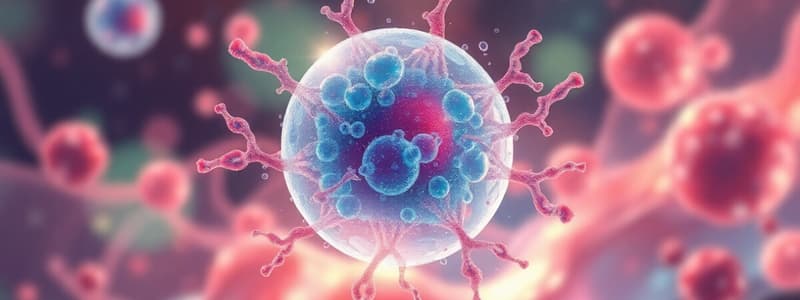Podcast
Questions and Answers
Who published Micrographia in 1665 and observed eukaryotic cells?
Who published Micrographia in 1665 and observed eukaryotic cells?
- Antonie van Leeuwenhoek
- Carl Linnaeus
- Robert Hooke (correct)
- Joseph Lister
Which scientist is known for observing bacteria in the 1670s?
Which scientist is known for observing bacteria in the 1670s?
- Matthias Schleiden
- Edward Jenner
- Louis Pasteur
- Antonie van Leeuwenhoek (correct)
What significant contribution did Ignaz Semmelweis make in 1847?
What significant contribution did Ignaz Semmelweis make in 1847?
- Developing the taxonomic naming system
- Discovering the first viruses
- Introducing hand washing to prevent childbed fever (correct)
- Presenting findings on spontaneous generation
What theory did Matthias Schleiden and Theodore Schwann develop in the 1830s?
What theory did Matthias Schleiden and Theodore Schwann develop in the 1830s?
Which event marked the beginning of the 'Golden Age of Microbiology'?
Which event marked the beginning of the 'Golden Age of Microbiology'?
Who was the first to observe eukaryotic cells?
Who was the first to observe eukaryotic cells?
What significant contribution did Edward Jenner make in 1796?
What significant contribution did Edward Jenner make in 1796?
Which theory was proposed by Matthias Schleiden and Theodore Schwann in the 1830s?
Which theory was proposed by Matthias Schleiden and Theodore Schwann in the 1830s?
Who implemented handwashing practices to prevent childbed fever in 1847?
Who implemented handwashing practices to prevent childbed fever in 1847?
Which major theory gained favor in the 1870-80s regarding disease causation?
Which major theory gained favor in the 1870-80s regarding disease causation?
What was discovered by Alexander Fleming in 1928?
What was discovered by Alexander Fleming in 1928?
Which important advance in immunization took place in the 1910-20s?
Which important advance in immunization took place in the 1910-20s?
Who was the first to prove that a microbe causes disease through their work on anthrax?
Who was the first to prove that a microbe causes disease through their work on anthrax?
Flashcards
Microbiology Timeline
Microbiology Timeline
A chronological sequence of events related to microbiology discoveries.
Robert Hooke's contribution
Robert Hooke's contribution
Observed eukaryotic cells in 1665, documented in Micrographia.
Antonie van Leeuwenhoek's discovery
Antonie van Leeuwenhoek's discovery
Observed bacteria, a major development in microbiology, in the 1670s.
Germ theory of disease
Germ theory of disease
Signup and view all the flashcards
"Golden Age of Microbiology"
"Golden Age of Microbiology"
Signup and view all the flashcards
Who discovered bacteria?
Who discovered bacteria?
Signup and view all the flashcards
What is Spontaneous Generation?
What is Spontaneous Generation?
Signup and view all the flashcards
Who challenged Spontaneous Generation?
Who challenged Spontaneous Generation?
Signup and view all the flashcards
What is Aseptic Technique?
What is Aseptic Technique?
Signup and view all the flashcards
Who invented Vaccines?
Who invented Vaccines?
Signup and view all the flashcards
Koch's Postulates
Koch's Postulates
Signup and view all the flashcards
What is Cell Theory?
What is Cell Theory?
Signup and view all the flashcards
What is Immunity?
What is Immunity?
Signup and view all the flashcards




